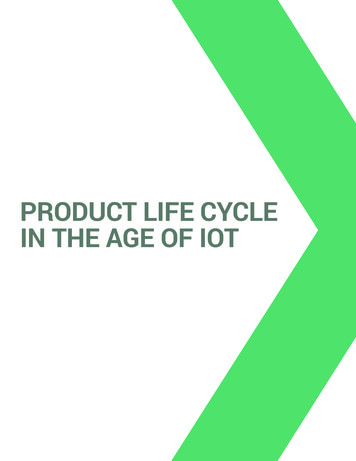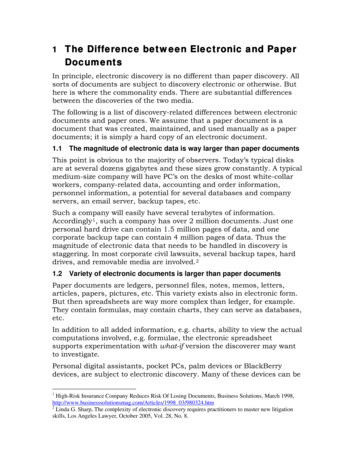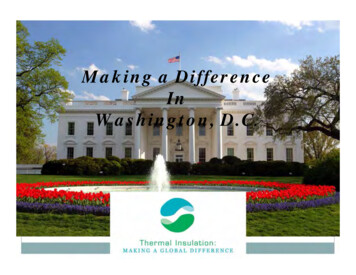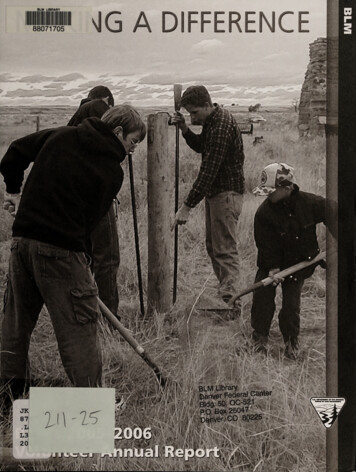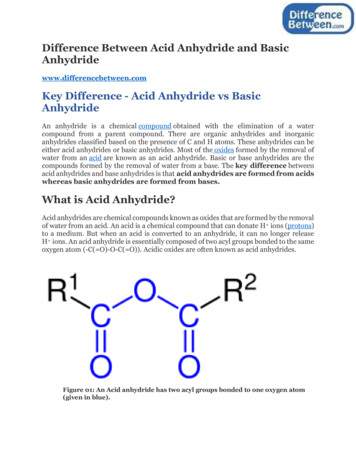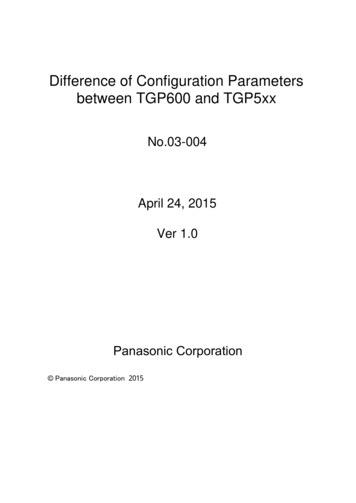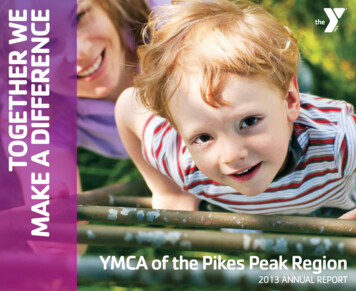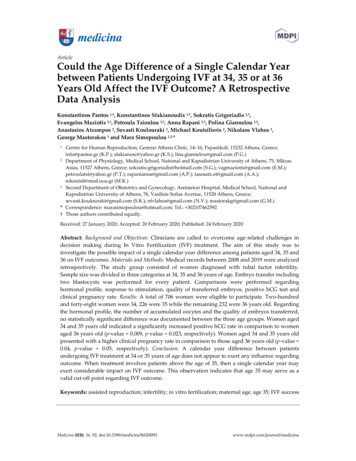
Transcription
ArticleCould the Age Difference of a Single Calendar Yearbetween Patients Undergoing IVF at 34, 35 or at 36Years Old Affect the IVF Outcome? A RetrospectiveData AnalysisKonstantinos Pantos 1,†, Konstantinos Sfakianoudis 1,†, Sokratis Grigoriadis 2,3,Evangelos Maziotis 2,3, Petroula Tsioulou 2,3, Anna Rapani 2,3, Polina Giannelou 1,2,Anastasios Atzampos 2, Sevasti Koulouraki 3, Michael Koutsilieris 2, Nikolaos Vlahos 3,George Mastorakos 3 and Mara Simopoulou 2,3,*1Centre for Human Reproduction, Genesis Athens Clinic, 14–16, Papanikoli, 15232 Athens, Greece;info@pantos.gr (K.P.); sfakianosc@yahoo.gr (K.S.); lina.giannelou@gmail.com (P.G.)2 Department of Physiology, Medical School, National and Kapodistrian University of Athens, 75, MikrasAsias, 11527 Athens, Greece; sokratis‐grigoriadis@hotmail.com (S.G.); vagmaziotis@gmail.com (E.M.);petroulatsi@yahoo.gr (P.T.); rapanianna@gmail.com (A.P.); tasosatz.et@gmail.com (A.A.);mkoutsil@med.uoa.gr (M.K.)3 Second Department of Obstetrics and Gynecology, Aretaieion Hospital, Medical School, National andKapodistrian University of Athens, 76, Vasilisis Sofias Avenue, 11528 Athens, Greece;sevasti.koulouraki@gmail.com (S.K.); nfvlahos@gmail.com (N.V.); mastorakg@gmail.com (G.M.)* Correspondence: marasimopoulou@hotmail.com; Tel.: 302107462592† Those authors contributed equally.Received: 27 January 2020; Accepted: 20 February 2020; Published: 24 February 2020Abstract: Background and Objectives: Clinicians are called to overcome age‐related challenges indecision making during In Vitro Fertilization (IVF) treatment. The aim of this study was toinvestigate the possible impact of a single calendar year difference among patients aged 34, 35 and36 on IVF outcomes. Materials and Methods: Medical records between 2008 and 2019 were analyzedretrospectively. The study group consisted of women diagnosed with tubal factor infertility.Sample size was divided in three categories at 34, 35 and 36 years of age. Embryo transfer includingtwo blastocysts was performed for every patient. Comparisons were performed regardinghormonal profile, response to stimulation, quality of transferred embryos, positive hCG test andclinical pregnancy rate. Results: A total of 706 women were eligible to participate. Two‐hundredand forty‐eight women were 34, 226 were 35 while the remaining 232 were 36 years old. Regardingthe hormonal profile, the number of accumulated oocytes and the quality of embryos transferred,no statistically significant difference was documented between the three age groups. Women aged34 and 35 years old indicated a significantly increased positive hCG rate in comparison to womenaged 36 years old (p‐value 0.009, p‐value 0.023, respectively). Women aged 34 and 35 years oldpresented with a higher clinical pregnancy rate in comparison to those aged 36 years old (p‐value 0.04, p‐value 0.05, respectively). Conclusion: A calendar year difference between patientsundergoing IVF treatment at 34 or 35 years of age does not appear to exert any influence regardingoutcome. When treatment involves patients above the age of 35, then a single calendar year mayexert considerable impact on IVF outcome. This observation indicates that age 35 may serve as avalid cut‐off point regarding IVF outcome.Keywords: assisted reproduction; infertility; in vitro fertilization; maternal age; age 35; IVF successMedicina 2020, 56, 92; edicina
Medicina 2020, 56, 922 of 101. IntroductionChildbearing beyond the age of 35 has experienced an increasing trend in developed countriesduring the last few decades. A striking example is the United States of America (USA), where duringthe period between 1970–2000, the number of pregnancies for women over 35 has increasedeight‐fold [1]. The apposite term employed for women over the age of 35 who experience pregnancyis Advanced Maternal Age (AMA) [1]. The highly demanding aspects of modern life, the rigorouspursuit of educational and professional growth combined with the efforts towards acquiring a highstandard of living pose as catalysts resulting in the delay of marriage and the acquisition of offspring[2]. However, as clearly documented, AMA may be related to infertility, thus in this case it maystand as an issue jeopardizing a couple’s efforts to achieve a natural conception. Nonetheless, theabundancy of options offered in the field of assisted reproduction, from oocyte cryopreservation tooocyte donation, paves the way for a ground‐breaking era in reproduction [2].A plethora of published data suggests that AMA exerts a negative impact on pregnancyoutcomes accompanied with poor prognosis, both of which are associated with a variety ofcomplications during both the gestational and delivery stage [3–10]. In addition, women over 35report poorer results during In Vitro Fertilization (IVF) treatment due to inadequate ovarianstimulation as well as a lower embryo implantation rate [11,12]. The aforementioned risks certainlytranslate as concerns, rendering management of such patients within the assisted reproductioncontext as a rather challenging task for fertility specialists.Women over the age of 35 represent a considerable percentage of IVF patients. Regardingmanagement, in light of various risks and complications related to AMA, clinicians are confrontedwith a series of concerns and ethical considerations, incorporating both risks and advantages in thedecision‐making process. Concerning oocyte or embryo donation, as well as gestational surrogacy,clinicians are called to set an age cut‐off point lacking any conclusive guidelines. Despite guidelines[13,14], empirical decisions often dictate the adopted strategy while the demand for a universalprotocol has been voiced [15]. A typical example refers to the maximum number of embryostransferred in a single cycle. According to existing guidelines, the age cut‐off point dictating thisdecision is 35 years, whereas for younger women, elective single embryo transfer (eSET) is preferred[16]. In Europe in particular, this decision normally complies with specific legislation. In Belgium,for women under the age of 36, the number of embryos transferred is limited to one, whereas inFrance and Sweden the maximum number of embryos is two. In Greece, according to currentlegislation the cut‐off point is the age of 35, while for women under the age of 35 years, transferringtwo embryos is allowed exclusively under specific circumstances. In Germany, for patients underthe age of 37, the maximum number of embryos that can be transferred is three. Finally, in theUnited Kingdom and the Netherlands, eSET is considered to be the method of choice [17].The age cut‐off points employed by clinicians towards decision making in AssistedReproduction Technology (ART) vary, despite extensive research dedicated to shedding light to theimpact of AMA on fertility [15,18,19]. Indicatively, there are different schools of thought on whetherthe age of 35 [20,21] or the age of 40 [22] should be adopted as the appropriate cut‐off point whenassociating AMA to a statistically significant negative prognosis and pregnancy outcome.Taking into account the divergent schools of thought and respective practices, studiesinvestigating the clinical outcome regarding immediate age surrounding the presumed cut‐off pointare timely and essential. What a difference could a single calendar year make regarding the IVFoutcome when we consider a patient’s journey undergoing treatment from 34 to 35 and 36 years ofage? Addressing this question is of added value equally from the perspective of the practitioner andthe patient. Does deviating by a single year from the cut‐off point of 35 present with substantialdifferentiation regarding decision‐making on the number of embryos transferred? What is the realimpact of age in trying to minimize complications such as multiple pregnancies and maximize thepossibility of a positive outcome? How does exact age weigh in the equation? These issuesemphasize the crucial nature of this study. The scope of this study is to address the issue of whethera single calendar year difference between patients undergoing IVF treatment at age 34, 35 and 36,
Medicina 2020, 56, 923 of 10respectively, could affect the IVF outcome. Further to that, results could provide insight withregards to how appropriate it is to consider the age 35 as a cut‐off point in IVF treatment for patientsshowcasing a positive reaction to stimulation. Notably, since the existing literature principallyreports on data referring to age cohorts of a wider range, the present study contributes in a uniquemanner. To the best of our knowledge, this report explores—for the first time—the impact of exactage employing a comparison between the adjacent calendar years 34 and 36 surrounding 35 as theage cut‐off point in association to a positive prognosis for IVF.2. Materials and MethodsA clinic’s medical records were investigated from 2008 to 2019 in order to recruit patients forthis retrospective data analysis. The Genesis Athens Clinic Hospital Ethics Board approved thestudy protocol in accordance with the Helsinki declaration (130/26/3/2019). Tubal factor infertilitywas the filed diagnosis for the patients who were submitted to a single IVF treatment cycle. Theimplemented inclusion criteria enabled recruitment of women with primary infertility attributed toa tubal factor which was confirmed employing hysterosalpigography indicating tubal blockage or aremoved salpinx following hydrosalpinx diagnosis or fallopian tube(s) blockage. This etiology ofpatients’ infertility was chosen during conceptualization of the study due to its favorable clinicalend‐point potential. The women included were normo‐ovulatory with regularity of menstruation of24–35 days.The Controlled Ovarian Hyperstimulation (COH)’s protocol of choice was the standardGonadotropin‐Releasing Hormone (GnRH) long agonist protocol. On the 21st day of the cycle, 0.1 mgGnRH agonist was administered. A daily prescription of gonadotropin at 300 international units (IU)was also administrated. Sonographic assessment of follicular development was used as a guide forthe adjustment of gonadotropin dose. Oocyte retrieval procedure was scheduled for 36 h followingHuman Chorionic Gonadotropin (hCG) injection. Progesterone administration was opted for toprovide luteal support. An acquisition of 10 oocytes was considered as a good ovarian response.Three major groups were formulated based on patients’ age, namely 34, 35 and 36 years of age.Embryo transfer procedure was performed on day 5, including two embryos at the blastocyst stage.Patients were further subcategorized based on the criterion of embryo quality during the day 5Embryo Transfer (ET) procedure. Two top quality embryos at the blastocyst stage graded as 4AA,5AA, and 6AA were categorized in the group of D5A. Any other embryos at the blastocyst stagewere characterized as non‐top quality embryos. Category D5B included a top‐quality blastocystalong with a non‐top quality one. Lastly, category D5C consisted of two blastocysts that were bothassessed as non‐top quality. Gardner’s blastocyst grading system was employed as the gradingsystem of choice in assessing the blastocyst [23].Standard IVF was the insemination technique performed for all patients included in the presentdata analysis. We aimed to exclude any issues that may hinder a positive end‐point in cases ofparticipants with good prognosis and consequently pose as confounders jeopardizing this study,meaning male factor infertility or any further etiologies jeopardizing the couple’s fertility potentialwere excluded. The aforementioned inclusion criteria were meticulously selected to confirm andestablish that solely good prognosis patients with enhanced probability to achieve pregnancyfollowing a single IVF treatment would be incorporated in the present analysis. According to theirfiles, patients meeting the inclusion criteria were sorted into the abovementioned age groups.A statistical analysis was conducted to perform a comparison in regards to the basic hormonalprofile between the three groups of patients. Profiling included Follicle Stimulating Hormone’s(FSH), Luteinizing Hormone’s (LH) levels, Estradiol’s levels and Anti‐Müllerian Hormone’s (AMH)levels. Measurement of FSH and LH levels was conducted on the 3rd day of the menstrual cycle,while estradiol’s levels were determined on the day of HCG trigger employing chemiluminescentmicroparticle immunoassay on a Roche Immunoanalyser (Roche Cobas e 411). On the 3rd day of themenstrual cycle, an analysis of AMH levels was requested, employing AMH Gen IIchemiluminescent microparticle immunoassay on a Roche Immunoanalyser (Roche Cobas e 411).
Medicina 2020, 56, 924 of 10A statistical comparison was conducted amongst the three age groups including: The numberof oocytes accumulated, the number of normally fertilized oocytes, the assessment of quality ofembryos included at embryo transfer, the positive hCG test rate, as well as the clinical pregnancyrate. Assessment of a positive hCG test rate was performed based on the number of times that apositive beta human chorionic gonadotropin test (beta hCG) was detected in maternal serum sevendays post blastocyst transfer. Subsequently, assessment of clinical pregnancy rate was performedbased on the cases in which ultrasound detection of a fetal heart beat confirmed pregnancy 6–7weeks following the last menstruation.The R Programming Language for Statistical Purposes was employed for all data analyses.Profiling of hormonal levels, the number of accumulated oocytes and the number of normallyfertilized oocytes were compared amongst the three age groups with One Way ANOVA test andBonferroni Correction Post‐hoc analysis. Contingency chi‐squared test was applied to compare thetransferred embryos’ quality, the positive hCG test rate and the clinical pregnancy rate. ConfidenceIntervals (CI) of 95% were calculated for each variable and p‐value
Conclusion: A calendar year difference between patients undergoing IVF treatment at 34 or 35 years of age does not appear to exert any influence regarding outcome. When treatment involves patients above the age of 35, then a single calendar year may exert considerable impact on IVF outcome. This observation indicates that age 35 may serve as a

